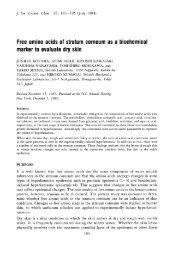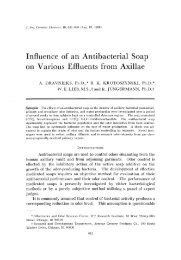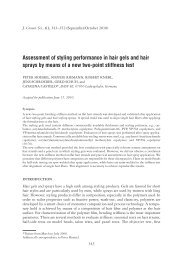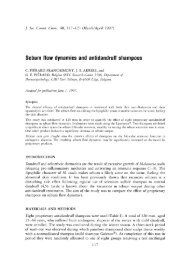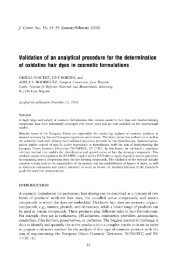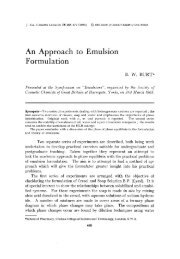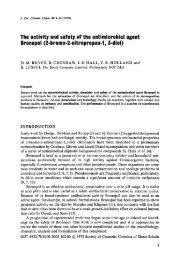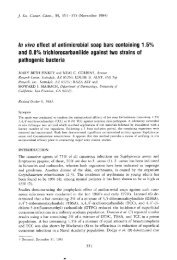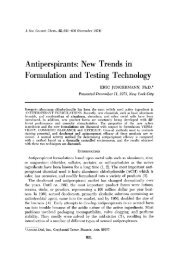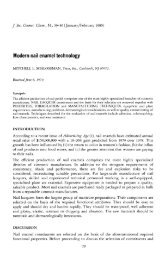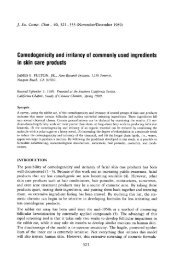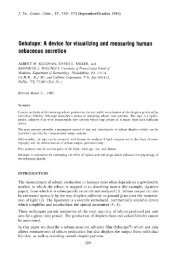A Critical Comparison of Two Procedures for Antiperspirant Evaluation
A Critical Comparison of Two Procedures for Antiperspirant Evaluation
A Critical Comparison of Two Procedures for Antiperspirant Evaluation
You also want an ePaper? Increase the reach of your titles
YUMPU automatically turns print PDFs into web optimized ePapers that Google loves.
272 JOURNAL OF THE SOCIETY OF COSMETIC CHEMISTS<br />
but with these data we have found no evidence <strong>for</strong> the effect. If it existed, the<br />
expectation would be that the point estimates <strong>of</strong> per cent reduction obtained<br />
with the regular SSEM method (concurrent controls) would be biased in an<br />
upward direction (inflated), while the use <strong>of</strong> pretest controlshould give lower<br />
PR values. If the cork effect were small or nonexistent, on the other<br />
hand, the two methods should vary in their outcomes in a random manner<br />
with, <strong>of</strong> course, larger errors when a priori controls are used. Our results on<br />
these sets <strong>of</strong> data do not show any consistency which could be considered<br />
significant; there were 4 eases in which the a priori controls yielded higher<br />
per cent reductions than those obtained with concurrent controls and one in<br />
which they were lower. We there<strong>for</strong>e believe that any cork effect in the dataif<br />
it exists at all-must be small.<br />
Other Models<br />
The discussion and examples in this paper have been confincd to experiments<br />
in which only two "treatments" were considered: antiperspirant and<br />
control. However, it is possiblc to use three or even a greater number <strong>of</strong><br />
treatments. In fact, at this laboratory the usual evaluation is a three-sample<br />
procedure in which a control and two different antiperspirants are tested. The<br />
orclinary SSEM procedure is used, but the design, instead <strong>of</strong> being a crossover,<br />
is a <strong>for</strong>m <strong>of</strong> balanced incomplete blocks structure known as a Youden<br />
square. A schematic picture <strong>of</strong> such a design is shown in Fig. 2. The analysis<br />
substantially more complex than that <strong>of</strong> the crossover, but is easily and quickly<br />
done with even small computer facilities and can be done in a few hours<br />
with a desk calculator. A similar design can be used <strong>for</strong> 5 samples. This is<br />
illustrated in Fig. 3.<br />
Finally, there is a model <strong>for</strong> thc two-sample test which may be superior in<br />
some ways to the crossover we have recommended. We are just beginning to<br />
S• Sa S• S• S• S• S•S•7S•e<br />
A 1<br />
A2<br />
T 1 T2 T 3<br />
T 2 T 3 T1<br />
A 1<br />
A 2<br />
T 1 T2 T3<br />
T2 T 3 T 1<br />
A 1<br />
A 2<br />
T1 T 2 T 3<br />
T 2 T 3 T 1<br />
(Type I<br />
Squares)<br />
A 1<br />
A2<br />
$19520S21 $22S2352• S3•S35S36<br />
T2 T3 T1<br />
A1 I T2 T3 T1<br />
T1 T2 T3 A2 I T1 T2 T3<br />
A 1<br />
A 2<br />
T2 T 3 T 1<br />
T1 T 2 T 3<br />
(Type II<br />
Squares )<br />
Figure 2. Three-sample test design (9, x 3 Youden squares) (illustrated <strong>for</strong> 36 subjects): Ai<br />
represents axillae, where i equals 1 or 2; Tj represents treatments (including control),<br />
where j----1, 2, or 3; and Sk representsubjects, where k = 1, 2 . . . 36. (Appropriate<br />
randomization not shown.)



